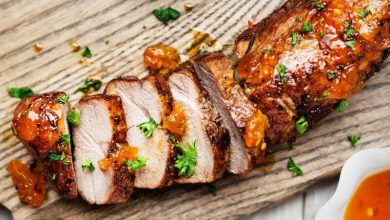Certainly! Scalloped Potatoes is a classic dish that consists of thinly sliced potatoes baked in a creamy sauce. It’s often baked until the top becomes golden and crispy. This dish is rich and comforting, making it a favorite for many.
History:
Scalloped Potatoes have been enjoyed for generations, and its exact origin is a bit unclear. However, it’s believed to have roots in European cuisine, particularly French and Irish. Potatoes were a staple crop in many European countries, and people found creative ways to prepare them. The dish likely made its way to America through immigrants and has become a popular side dish in various regions.
Components:
The main components of Scalloped Potatoes are:
- Potatoes: Thinly sliced potatoes are the star ingredient. Varieties like Russet or Yukon Gold work well due to their starch content.
- Creamy Sauce: A mixture of heavy cream, milk, or a combination of both creates a rich and creamy base for the dish.
- Cheese: Some variations include layers of grated cheese, often cheddar or gruyere, which melt into the sauce and add flavor.
- Seasonings: Common seasonings include salt, pepper, garlic, and sometimes a pinch of nutmeg for extra depth of flavor.
Steps to Prepare Scalloped Potatoes:
- Prep Potatoes: Peel the potatoes if desired, then slice them into thin rounds using a mandoline or a sharp knife.
- Prepare Sauce: In a saucepan, heat heavy cream (or a mixture of cream and milk) over medium heat. You can also add minced garlic for extra flavor. Season with salt, pepper, and a pinch of nutmeg if desired.
- Layer Potatoes: Grease a baking dish with butter. Begin by arranging a layer of overlapping potato slices at the bottom of the dish.
- Add Sauce and Cheese: Pour a portion of the creamy sauce over the potatoes, ensuring they are covered. Sprinkle a layer of grated cheese over the sauce.
- Repeat: Repeat the layering process until you’ve used all the potatoes. Make sure the top layer is covered with sauce and cheese.
- Bake: Cover the dish with aluminum foil and bake in a preheated oven at around 375°F (190°C) for about 45-60 minutes. Then, remove the foil and bake for an additional 15-20 minutes, or until the top is golden and the potatoes are tender.
- Serve: Let the Scalloped Potatoes rest for a few minutes before serving. This allows the dish to set and makes it easier to serve.
Time Needed:
The total time needed to prepare Scalloped Potatoes can vary. It usually takes about 15-20 minutes for prep and assembling, followed by around 1 hour and 15-20 minutes for baking. So, in total, you can expect the dish to be ready in approximately 1 hour and 30-40 minutes.
Enjoy your delightful and creamy Scalloped Potatoes!
Is there anything else you would like to know or explore?
Certainly! Here are the nutrition facts and some health information for a serving of Scalloped Potatoes:
Nutrition Facts (Approximate values for a typical serving):
- Serving Size: 1 cup (about 245g)
- Calories: Around 250-300 calories
- Total Fat: Approximately 15-20g
- Saturated Fat: Around 8-10g
- Cholesterol: About 40-50mg
- Sodium: Approximately 400-500mg
- Total Carbohydrates: Around 20-30g
- Dietary Fiber: Roughly 2-4g
- Sugars: Approximately 2-4g
- Protein: Around 6-8g
Health Information:
- Scalloped Potatoes are a rich and indulgent dish due to the creamy sauce and cheese used in its preparation. As a result, it tends to be higher in calories, saturated fat, and sodium.
- The dish is a good source of carbohydrates, providing energy.
- The dietary fiber content is relatively low, which means that while it’s filling, it may not contribute significantly to your daily fiber needs.
- Potatoes are naturally rich in potassium and vitamin C, but the baking process might cause some loss of these nutrients.
- The dish’s high saturated fat content comes from the cream and cheese, which may not be suitable for those with dietary restrictions or those looking to reduce saturated fat intake.
- Due to its calorie and fat content, Scalloped Potatoes are best enjoyed in moderation as an occasional treat rather than a regular part of a balanced diet.
Remember that the exact nutrition content can vary based on the recipe and portion size. If you’re looking to make this dish healthier, you might consider using lower-fat dairy options, using less cheese, and incorporating more vegetables for added nutrients and fiber.
Please consult with a healthcare professional or a registered dietitian for personalized advice on your dietary needs and goals.



